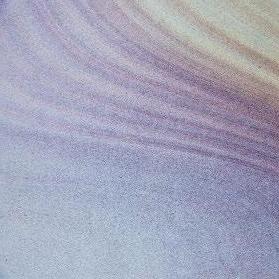
18 minute read
a narrative Informing a selection of Queensland’s principal flora
a narrative
Advertisement
By the early 1990s, I was no longer enthusiastic about carving more heraldry in the Great Court because it gave me no artistic satisfaction, the designs having been created by others long ago. Having recently carved the federal, state and territory floral emblems, in 1992, as no new work had been approved for carving, I took the opportunity – in consultation with anthropologists at UQ – to propose a selection of native flora considered significant in the cultural life of Indigenous people.
Dogrose to desert rose to database
During the 1990s, I had enjoyed carving European heraldry that included many Tudor roses and unidentified exotic trees and flowers. I was aware of numerous exotic flora subjects already depicted elsewhere on half-column capitals, like sugarcane, mango, poinsettia, passionfruit, grapes, and dozens of fanciful and unidentified subjects – and all those ‘dogroses’, with their four, five, six, seven, eight, nine or more petals! I rarely found Australian species represented.
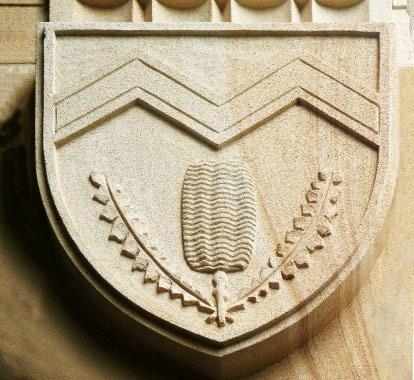
Murdoch University shield I always dutifully accepted the lists of subjects I was given for carving each year. So, along with the heraldic shields of Australian universities on the full-column capitals in the Great Court, the Commonwealth, state and territory floral emblems were to be represented on half-column capitals carved onsite during 1990–1991. They included Queensland’s Cooktown orchid, the Western Australian kangaroo paw, the Tasmanian blue gum, the New South Wales waratah, the Northern Territory Sturt’s desert rose, the South Australian Sturt’s desert pea, the heath representing the state of Victoria, and the Australian Capital Territory’s royal bluebell.
The Commonwealth floral emblem, the golden wattle, would have to be the most difficult flora subject I have ever had to carve. Making those small balls look soft and fluffy and not like a bunch of grapes was quite a task, but viewed from a distance I felt that all of my cutting and drilling was quite effective. I have often thought about how fortunate I am not to be in the shoes of some poor future sculptor who might have to carve a replica of my original.
When it came to carving monumental figures on either side of the main entrance to the Goddard building in 1989, I chose to include exotic flora species related to the research of the two celebrated naturalists, Charles Darwin and Gregor Mendel. On the side of the Darwin figure is an insectivorous plant, a climbing plant, as well as a fossil conifer and two leaf fossils collected when he visited Australia as a young man in 1826. The design on Gregor Mendel’s embroidered mitre hat on the other side of the doorway is based on the fuchsia flowers he hybridised in his monastery garden, and four pea plants are depicted across the base.
It was great to carve native Australian flora on the armorial bearings of Australian universities, including a stylised form of banksia on the Murdoch University shield, five flowers of the Illawarra flame tree on the Wollongong University shield, a large Sturt’s desert rose on the Charles Darwin University shield, and heath included on the heraldic shield of La Trobe University. Twice I repeated the Cooktown orchid on the Mansfield Place side of the vehicular entry and it was the only example of the state of Queensland’s principal flora included in this series. Quite by chance, I chose to carve both of these sprays of flowers on pink Helidon freestone that appears close to the actual colour of the real flower when the stone is clean.
ACT: Royal bluebell NSW: Waratah

SA: Sturt’s desert pea TAS: Blue gum NT: Sturt’s desert rose QLD: Cooktown orchid
VIC: Heath WA: Kangaroo paw AUS: Golden wattle.
AUS: Golden wattle
I had enjoyed carving all of that flora as directed, but after delving into the UQ archives, I learnt that one of the objectives of the carvings in the Great Court was to depict the state of Queensland’s principal flora. This fact emboldened me to propose new subjects that fulfilled that original objective. Attitudes towards the beauty and importance of our own native flora had certainly changed since decisions for the subjects of carvings were first made and, as the principal flora of Queensland had mostly been overlooked to date, I was keen to correct this. I consulted with botanists on staff before choosing an interesting selection of plants that would record the social life of Indigenous people, as well as celebrate the achievements of UQ staff and graduates.
As there was no existing record of the flora already depicted in the Great Court carvings, I realised that I needed to make that record myself before I could possibly prepare a new selection without repetition. Thus, one incredibly hot November afternoon during a Brisbane heatwave in the late 1990s, I began my walk around the cloisters, recording flora subjects in pencil on ruled-up foolscap pages and using the 1996 Guide to the Great Court numbering system for the columns. My initial documentation of the existing carved flora took many weeks and filled copious pages with information.
I began with the common names of flora and added the up-to-date scientific names, as well as the dates they were carved and, wherever possible, the sculptor’s name. Unfortunately, because of the house fire that destroyed all of Muller’s records, I had little information about flora carved before my time. To complete the identification of much of the flora, I sought the assistance of retired UQ staff members, eminent Queensland botanists Joan and Dr Alan Cribb. They quickly applied themselves to the task of walking around the cloisters and positively identifying any plant that was identifiable. Their detailed observations were added to my lists and became the basis of an exhaustive record of all of the carvings in the Great Court that then consumed me off and on for the next 14 years. All of these pages of handwritten information were delivered to the Property and Facilities office and typed up by the office staff. When the lists were returned to me, I realised that people without scientific training had become involved and that many scientific names were now incorrectly recorded – despite my carefully handwritten original guide. That typed document was useless.
My friend, Dr Hugh Lavery AM, esteemed environmental scientist and UQ alumnus, offered to have his assistant compile the lists in a professional way, and thus our work together began on a database that finally recorded all of the carvings on all UQ campuses in Ipswich, Gatton and St Lucia. That database was finally completed, checked onsite and delivered to the UQ Art Museum in August 2012. It became the basis for a new guide to the Great Court entitled Carving a history: a guide to the Great Court published in 2016, along with an app providing access to the comprehensive database.
From exotic to native
Rather than continuing the depiction of exotic flora species, I chose a list of native flora subjects for the half-column capitals in the Michie building cloister, where I had begun my first work on site in 1980 carving the armorial bearings of UQ’s Colleges.
Because of the proximity of the Anthropology Museum to the Michie building cloisters, I proposed that the subjects reflect the usefulness of various flora species to the Aboriginal and Torres Strait Islander peoples of South East Queensland – not only for the provision of food but also for medicinal purposes and for making implements. Many of these plants were represented in a garden on the north-western side of the Michie building. Dr Peter Lauer gave me pages from a booklet he had prepared for the Anthropology Museum in 1986, Significant plants of the Butchulla people on Fraser Island and in Hervey Bay, which provided me with descriptions of the uses Indigenous people had made of many native plants, and from these I chose 20 subjects.
I submitted my proposal to the Senate Art Committee for its consideration and, following its approval, I began work onsite in 1992 with renewed enthusiasm, completing the series two years later. Because I was able to obtain specimens of these plants, I used them as on-the-spot reference for the work and just carved intuitively, using only sparse construction lines to determine the thrust of the image.
South East Queensland provided a rich and diverse menu for the local people, and edible species included the very important Bunya pine, a species of particular interest to me. Several huge old specimens, perhaps up to 20 metres in height, had grown beside the lawn tennis court at my childhood home, an old Queenslander on the riverbank at Yeerongpilly in Brisbane, where renowned artist Lloyd Rees had also lived for a short time during his very early childhood. When preparing to write his book, Peaks and Valleys, in 1985, he returned to our home with his son to photograph some aspects of the property. It was always believed that a Bora Ring had once existed there, although no traces were evident when we moved to the property in 1954. These
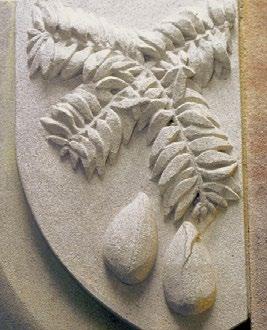
Bunya pine
Cabbage tree palm huge trees that had been recorded in John Oxley’s field notebooks as he proceeded up the Brisbane River towards Oxley Creek in 1823 would certainly indicate the possibility of the existence of such a sacred site. When extensive outcrops of Bunya pines in the Blackall and Stanley Ranges were fruiting, they were a magnet for the huge ceremonial gatherings that were also used for trade purposes. From personal experience, I recall that those nuts were quite delicious when Mother either baked or boiled them for us to enjoy.
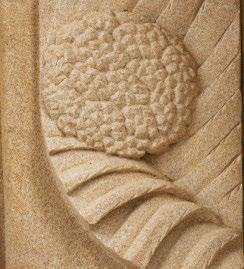
On the available half-column capital there was only room to carve one prickly frond and a nut shed from the fibrous husk that binds many together into a very large heavy cone about the size of a soccer ball. When ripe, a cone can fall from a great height without warning and smash open with deadly results for anyone below. There were many large dents in our lawn tennis court caused by such events! Because of my father’s interest and knowledge of local history and fear of a proposed riverside road being constructed by Brisbane City Council, I believe that he had proposed that those particular Bunya pines in Yeerongpilly should be heritage listed, but subsequent property developers felled them after my family left the district. These magnificent landmarks have gone, just like so many of the Bora Rings.
Along with the kernel of the Bunya nut, the whole root or rhizome of the gristle fern or bungwall fern was bruised and roasted and was a most important part of the diet of Indigenous people. It was a very attractive subject to carve near the armorial bearings of St Leo’s and Cromwell Colleges.
Palms had an important role in the dreaming stories of the coastal people, and the Livistona or cabbage tree palm is included in this series. Its fresh young leaves mixed with honey made a delicious fresh salad. It became the inspiration for
another of my artworks, commissioned for the sculpture garden at The Maroochy Regional Bushland Botanic Gardens on the Sunshine Coast, where the species still flourishes bordering the Sculpture Garden. I had thought of the many uses to which every part of this plant had been put, and hence I entitled that artwork The gift.
Then, at the vehicular end of this series in the cloister, I carved the pandanus, commonly known as bread fruit and found along the coastal fringe of the east coast of Australia. It is very important to the health, culture and economic life of the people of the Pacific region.
I found my sample of the so-called nut palm, or cycad, in a neighbour’s garden during my regular morning walk, and took a few photographs for reference when it bore fruit. Only after a prolonged process of repeated pounding, rinsing and baking was this plant rendered edible. Untreated, the fruit of this plant was as toxic as the next specimen I was about to carve, the cunjevoi, a lily-like plant with very large leaves that I had often seen on visits to rainforests over the years. I could only fit a scaled-down version of its huge leaf on the half-column capital inside the cloister.
Lilly pilly trees were also once common in the rainforests bordering the lower reaches of the Brisbane River, and their plentiful pink and white fruit were gathered and eaten by locals throughout the region. Now, they are popular in Brisbane gardens and it was easy to obtain a sample before carving a sprig just inside the cloister beside the badge of International House.
Nearby, I carved a native black orchid that grows in tree hollows, with fleshy drooping leaves and a handsome scarlet hanging flower with edible tubers.
Among the most useful of plants included in the series is the melaleuca, tea tree or paperbark. Dominant in coastal swamplands, the bark could become a ready blanket and its flowers drew the honey bees. It was easy for me to get a specimen as they are quite common street plants here in Brisbane. That same year at the entrance to Wordsmiths the Writers Cafe at UQ, I had carved a seat in memory of Aboriginal activist Kath Walker, or Oodgeroo Noonuccal as she came to be known (see page 69). Her name means paperbark and a large melaleuca tree planted beside that seat in her memory attracts swarms of native bees during its flowering season.
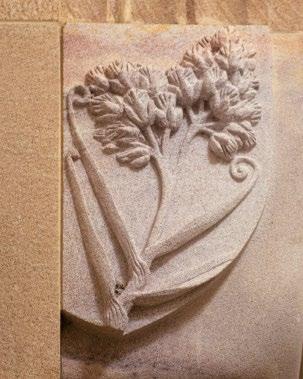
Another profusely flowering species carved nearby is the honeysuckle oak. Its nectar was attractive to native bees and birds and thus popular for generations. Widely distributed along the east coast of Australia, it can grow quite high and I still remember spending one memorable family Christmas holiday under an outcrop growing just beyond the low sand dunes at a beach on the Sunshine Coast. The family gathered in the shade there daily, and over time we decorated the largest tree with ornaments fashioned on the spot from remnants of gift paper and ribbons.
Close to the armorial bearings of Women’s College, I chose to carve a native species of flora called geebung, which has become the name of a north Brisbane suburb. Its fresh fruit was enjoyed by when ripe and sometimes preserved by burying it in the ground for retrieval at a later time.
Supplejack native vine Two native plants I included were used for medicinal purposes. The first is the convolvulus, which is carved beside the shield of La Trobe University. This plant is a trailing vine with large purple flowers and grows profusely on the sand dunes bordering many Queensland beaches. The rhizomes are edible and its crushed leaves were used to treat the painful sting of stingrays and stonefish.
The second species with a medicinal use is the Moreton Bay ash, carved in 1993 on the external wall of the cloister. This is my husband’s favourite eucalypt, which he came to admire in the days when he was a (very popular) scout leader, teaching generations of boys to appreciate the natural environment during bush camps organised in the Brisbane environs. These trees are easily recognised by the unusual tessellation of the lower bark that is included in the carving. This bark could be infused to prepare a tea for the treatment of dysentery.
Along the cloister is the magnificent grass tree that grows well on sheltered hillsides. Years ago, during a visit to Millmerran in western Queensland, I saw it thriving on a rocky hillside and recall that the nectar from its flowers had attracted swarms of bees and thus was a source of nourishing honey. Due to early morning exposure to the sun, these flowers bloom earlier on the eastern side of the spike and thus were observed as a compass. Because of its length, I was only able to show part of the flowering spike of the plant on a small half-shield surmounting a half-column capital next to the armorial bearings of King’s College.
Flowers of the cotton tree, commonly called the beach hibiscus, were carved at the cloisters’ vehicular entry. On many occasions in the early 1970s, I used to gather baskets full of these lovely paleyellow flowers to decorate our beach camp at Moreton Island, where we could enjoy watching them fade to a rich rusty-red by evening. Far from the glare of the city lights, we waited and watched in the darkness for early sightings of satellites crossing the night sky, making our own middens of drift oyster shells. Fibre gathered from these trees could be made into strong fishing nets.
Along the wall inside is represented the small-leaved Moreton Bay fig, which can grow up to six metres in height and is scattered throughout the Moreton Bay region, providing fruit for native animals and fibre for making dilly-bags.
Beside the fig are carved leaves of the macaranga, which naturally grows behind frontal sand dunes and on mountain slopes and is now a popular plant in native gardens in Brisbane suburbia. Several have self-seeded in my own courtyard over the years and I gathered a good leaf specimen during my morning walk along the banks of McKay Brook, a tributary of Moggill Creek that runs along the edge of my garden in Brisbane’s west. Its fibre was gathered for making twine and the timber was strong enough for making spears.
One of the most detailed flora subjects that I have had to carve in Helidon freestone is the carrol. This plant favours open situations
in light rainforests and grows profusely on the banks of creeks, and is an understory plant on my own hillside above the floodline of our creek. So, when it flowered profusely with clusters of tiny white blossoms, I collected a small flowering sprig and proceeded to spend a long time carving the detail. The UQ Anthropology Museum houses two boomerangs made from the timber cut from this plant.
Near the entrance to the Michie building is the flower and a fruiting stem of the red mangrove, which is an important plant because it provides breeding places for prawns, crabs, fish and other species, and its bark was used for tanning fishing nets. I still have one of my childhood treasures – a shiny crimson-coloured mangrove seed that I found one camping holiday at the beach.
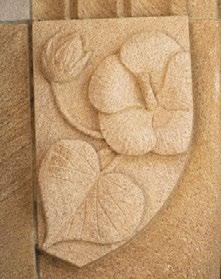
Early in 1994, I completed this series of flora with a climbing reed-cane, or supplejack native vine, at the entrance to the Michie building. A rambling rainforest plant, it appears plentifully along riverbanks in many places where the soil is moist, and I was interested to find detailed descriptions of its use in my very old copy of Tom Petrie’s Reminiscences of Early Brisbane, written by his daughter Constance. It’s one of many old books that my father had collected and I have dipped into it on many occasions for inspiration. She recorded that after the bark was chewed off, great lengths of the inner cane were useful for scaling high trees and were preserved afterwards by soaking in water to keep them supple.
It was while working in this cloister that I was dismayed to be advised that the sound of my carving had upset someone working in a nearby room. I was directed in writing not to work between the hours of 9am and 5pm, or to work only on weekends! In contrast, I had also just received an encouraging letter from an enthusiastic academic who wrote to Buildings and Grounds to let them know what a privilege it was to be able to observe history being made as each carving was completed just outside his own window overlooking my scaffold. As it was close to semester break, I waited and then continued on warily, managing to complete the series without causing further inconvenience or nuisance.
It was also here that I had my first and only accident onsite. My scaffolding was erected in a tight corner with the ladder entering the deck through a trapdoor that ended up right where I needed to stand when working. There was a narrow space between this trapdoor and the railings and one day, as I concentrated on the carving in front of my eyes, I moved and stepped down the hole. I suffered a lot of grazed skin and bruising as a result and it made me very wary about where I was putting my feet from then on.
I believe that this suite of carvings tells a really interesting story about the cultural life of Indigenous people in South East Queensland. Having the chance to choose and carve my own subject matter was not only satisfying for me, but I hope that my selection meets with the approval of the Traditional Custodians of the land.

Carrol Convolvulus Cotton tree
Cunjevoi Cycad
Grass tree Honeysuckle oak Geebung
Lilly pilly
Macaranga Moreton Bay ash Moreton Bay fig

Carving the coat of arms for Rough drawings of some of the first grotesques. the University of Tennessee, 1985








